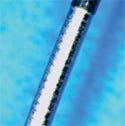Wireless data collected directly from patients during normal physical activities could enable the development of better knee implants
June 6, 2007
Originally Published MPMN June 2007
SPOTLIGHT
Laser Processing
Laser drilling with machine vision
|
A provider of laser machining services has augmented its ability to drill precise holes in polymer material by adding automated vision recognition to its process. The company programs its equipment to visually recognize color and pattern differences in material, and then uses the coordinates of these detected differences as reference points from which to locate its laser drills. The result is a process that can produce complex arrays of holes drilled in reference to any distinct structure embedded in polymer material. The process is suitable for machining catheter bodies reinforced with a metal braid. In this application the company can accommodate a braid’s inherent fluctuations and ensure that the holes are drilled only through the tube’s polymer apertures, leaving the braid intact.
Avicenna Technology Inc., Montevideo, MN
www.avicennatech.com
Cylindrical laser processing subsystems
|
Dedicated motion subsystems for cylindrical laser processing applications include an automated, pneumatically activated three-jaw gripper or ER collet for part holding. The gripper has a clear aperture for product feed-through and can be configured for OD, ID, or odd-form gripping with various jaw geometries. The ER collet chuck also has a clear aperture for product feed-through and can support tubing diameters from 0.5 to 30 mm. The LaserTurn series uses direct-drive noncontact motor and encoder technology for both the linear and rotary axes. Direct-drive motors exhibit significantly higher throughput and maintenance-free operation when compared with gear- and screw-driven technology, according to the company. Two platforms, the LaserTurn 2 and the LaserTurn 3, are also available to provide support for different requirements. Each product features automated material-handling capabilities and modular tooling platforms.
Aerotech Inc., Pittsburgh, PA
www.aerotech.com
Laser for flex-circuit processing
|
A compact laser system is designed to cut precise openings in polyimide cover layer foils and to cut flex circuits. The MicroLine UV 3000 system incorporates a high-speed linear drive for flexible circuits, minimizing processing times and making it an efficient component for any fabrication process. The system can perform precision cutting, routing, skiving, drilling, cutting pockets, structuring of etch or solder resist, and micromachining of ceramic substrates.
LPKF Laser & Electronics, Wilsonville, OR
www.lpkfusa.com
Microscale laser systems
|
Laser systems are available for processing parts down to the micron level. Laser fusion of polymers is one example of the company’s capabilities. All thermoplastic resins and thermoplastic elastomers can be joined pressure-tight and with nearly base material strength. Given the right choice of wavelength and additives, laser fusion achieves perfect surfaces without residual microparticles and adhesives or roughness. Since the laser beam as a cutting or welding tool does not wear out, consistent quality of cuts and joints is ensured, and the quality of workpieces can be maintained.
Rofin-Sinar Inc., Plymouth, MI
www.rofin.com
Laser-engraved plastic components
|
Precision-machined plastic components with laser engraving are free of the contamination of metallic debris or coolants associated with other engraving technologies. Polished polycarbonate parts are near-optical quality. ABS, PEEK, PVC, acetal, and other materials are also available for custom-machined parts. The company can offer engineering assistance, aid in material selection, and cost-efficiency.
Drummond Corp., Burton, OH
www.drummondcorp.com
Laser welding
|
Pulsed Nd:YAG laser services are available for welding high-reliability medical devices. The pulsed Nd:YAG laser process is the lowest-level-heat-input fusion welding method available, according to the company, which makes it a suitable choice for joining thin foils, small-diameter wires, and other assemblies that require minimal distortion. Research, process development, and production services are provided.
Precision Joining Technologies Inc., Miamisburg, OH
www.precisionjoining.com
Integrated laser markers
|
A company has designed a series of turnkey stations with part nesting, fume extraction, and safety circuits to provide high-resolution laser marking. The error-proof stations equipped with laser marking technology offer high throughput with multiple parts marked per cycle. Similar station concepts have integrated the laser markers into a dial-index design, allowing several processes to be incorporated into a single machine.
Invotec Engineering, Miamisburg, OH
www.invotec.com
Copyright ©2007 Medical Product Manufacturing News
You May Also Like









